The 4 C's + 1
The 4 C's + 1
The “4 C’s” are cut, color, clarity, and carat weight. We also like to include shape. These are the main factors in the pricing of a diamond and we are here to help you through this process. Whether you are looking for a vintage style ring or a custom design, we will help you find the center diamond that is perfect for you.
The First C: Cut
The cut of a diamond refers to its proportions and how it interacts with light. Properly cut diamonds reflect light beautifully, entering through the top facets and bouncing around inside like a prism, returning as a rainbow of colors. Improperly cut diamonds leak light through the bottom, diminishing their brilliance. Cut grades range from Ideal to Poor, with different laboratories having their own scales. The Gemological Institute of America (GIA) uses a scale from Excellent to Poor, with Excellent as the highest grade, while other labs like the International Gemological Institute (IGI) may use Ideal as their top grade.
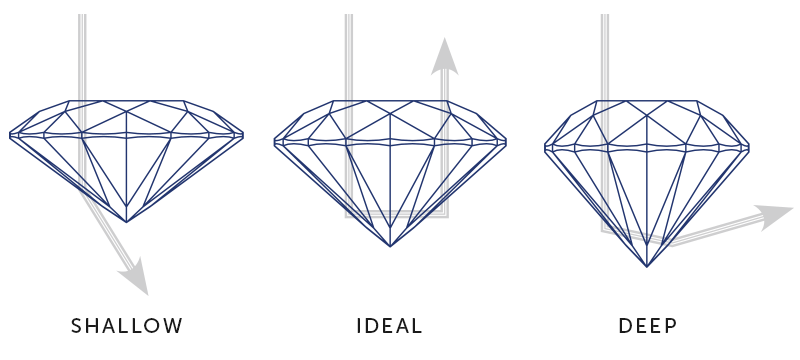
The Second C: Color
99% of diamonds have some degree of color to them. Diamond color can range from the more common yellow and brown to the very rare red, pink, blue and green. When it comes to white diamonds, color is graded on an alphabetical scale that begins with D and ends at Z. Diamonds with lower color than Z are considered Fancy color diamonds. Colorless and Fancy color diamonds are very rare, which increases their value significantly.
Colorless
Diamonds with color grades of D, E, and F are considered colorless diamonds. These diamonds are the rarest, and most white diamonds in the market. A good visual comparison for the color of colorless diamonds would be a clear glass of water.
Near Colorless
Diamonds with color grades of G, H, I, and J are considered near colorless diamonds. These diamonds have an extremely subtle tint of color that is very hard to detect to the untrained eye. A good visual comparison for the color of near colorless diamonds would be a glass of water with a single drop of tea in it.
Faint Color
Diamonds with color grades of K, L, and M are considered to have faint color. Faint color diamonds have a soft candle light color that appeals to many particularly in yellow gold and rose gold mountings.
Very Light Color
Diamonds with color grades of N,O,P, Q, and R are considered to have very light color. Diamonds of this color range are more economical in price, but tend to contrast noticeably with white gold or platinum mountings. Typically diamonds of this color are set in yellow gold or rose gold mountings
Near Colorless
Diamonds with color grades of S, T, U, V, W, X, Y, and Z have a noticeable yellow hue, but are not technically considered to be fancy yellow diamonds. Light color diamonds are popular for those who want a similar look to a fancy light yellow diamond without paying the premium associated with diamonds graded as fancy yellow.
Light Color
Diamonds with color grades of G, H, I, and J are considered near colorless diamonds. These diamonds have an extremely subtle tint of color that is very hard to detect to the untrained eye. A good visual comparison for the color of near colorless diamonds would be a glass of water with a single drop of tea in it.
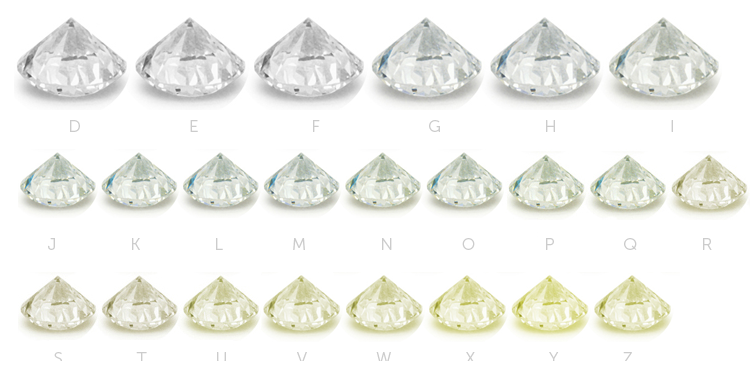
The Third C: Clarity
Clarity refers to the relative presence of inclusions (imperfections) within a diamond or the presence of surface abrasions, chips, or any other type of surface imperfections. Over 99.99% of diamonds have some sort of clarity characteristics which are used to assign these stones their appropriate clarity grades. Unless a diamond is deemed to be Flawless, it will have some form of clarity characteristic(s). From the least amount of clarity characteristics to the most, this is the industry accepted clarity scale.
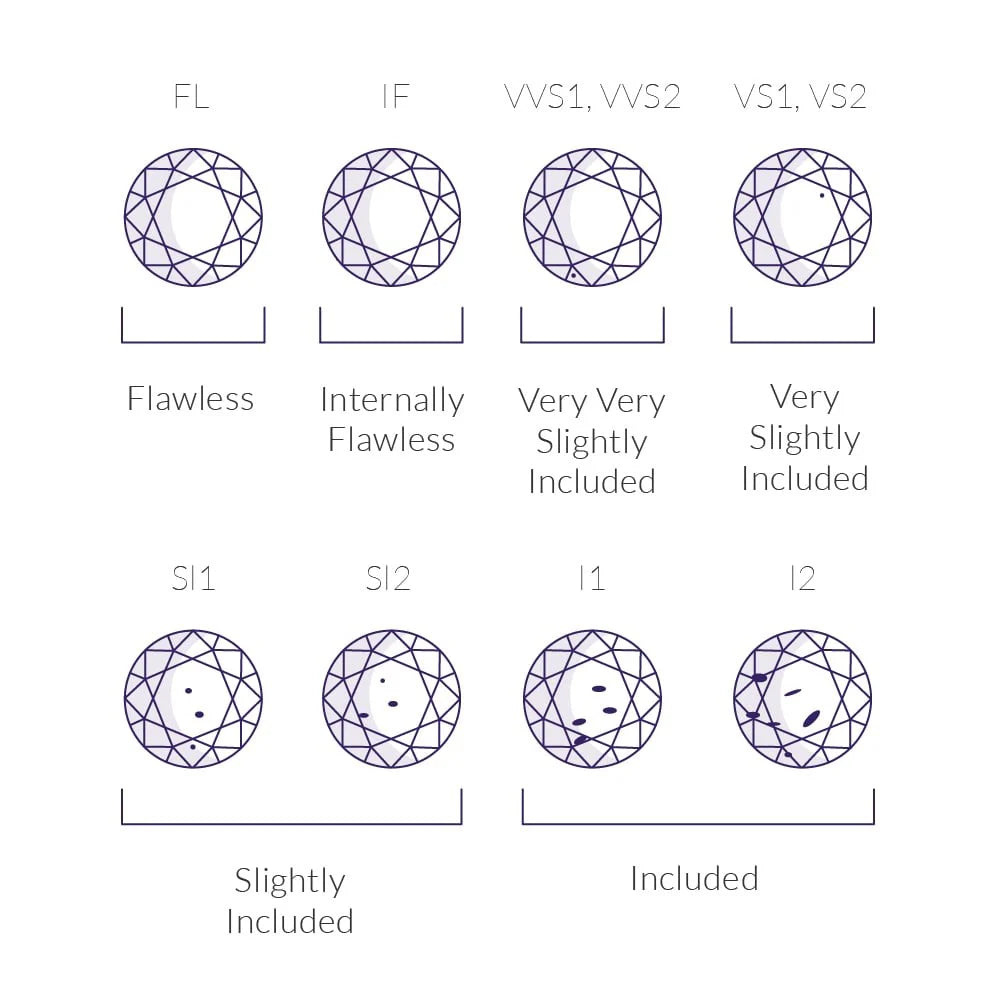
Flawless
As the name would imply, diamonds given the clarity grade of Flawless have no flaws or clarity characteristics within or on the surface of the diamond that can be seen at 10X magnification
Internally Flawless
Diamonds with a clarity grade of Internally Flawless have no inclusions within the diamond, but do have some form of clarity characteristic(s) on the surface of the diamond that can be seen at 10xX magnification.
VVS1 and VVS2
Diamonds with clarity grades of VVS1 and VVS2 contain inclusions that are so slight they are difficult for a skilled grader to see under 10x magnification.
VS1 and VS2
Diamonds with clarity grades of VS1 and VS2 contain Inclusions that can be observed with effort under 10x magnification, but can be characterized as minor.
SI1 and SI2
Diamonds with clarity grades of Si1 and SI2 contain inclusions that are noticeable under 10x magnification
I1, I2, and I3
Diamonds with clarity grades of I1, I2, and I3 contain inclusions that are visible without the aid of magnification. Diamonds of these grades have inclusions that may affect the transparency or brilliance of the diamond
The Fourth C: Carat Weight
Carat weight is the actual physical weight of a diamond, with one carat equaling 1/5th of a gram. The carat weight generally correlates with the diamond's size as viewed from the top, but improper cuts can affect this. A shallow cut can make a diamond appear larger but diminish its brilliance, while a deep cut can make it appear smaller and also reduce brilliance. Larger carat weight diamonds are rarer and more expensive, assuming all other quality factors are equal.
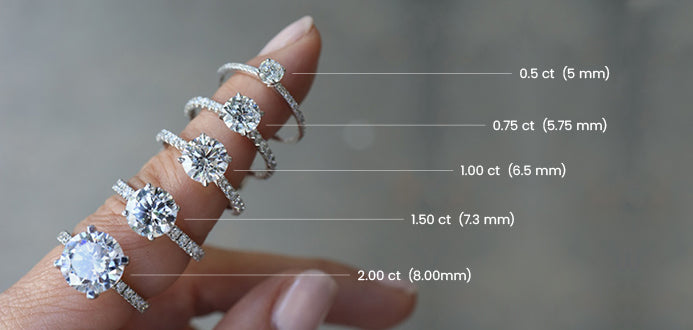
The +1: Shape
There is no right or wrong when choosing a diamond shape; it's all about personal preference. The shape of a diamond influences its price, with Round Brilliant cuts being the most popular and expensive due to their high demand and precision cutting. However, for small accent stones, Fancy Shapes can be pricier. While thousands of diamond shapes exist, we'll focus on those commonly used in engagement rings, as described by the Gemological Institute of America (GIA).

Round Brilliant
If you’re looking for a round diamond, the round brilliant cut is one of the most popular styles for engagement rings. It’s flattering on the finger, it captivates with its sparkle, and it’s a contemporary classic.
Princess Cut
A relative newcomer to the diamond universe, the princess cut was created in 1981 by Betzalel Ambar and Israel Itskowitz. GIA grading reports describe princess cut diamonds as square modified brilliants, distinguishing them from the step cut facet arrangements you find on other square diamonds like the Asscher cut. A princess cut diamond can also be rectangular or tapered. The princess cut is like an upside-down pyramid, with much of its weight in the pavilion, so the face-up appearance of the finished diamond may appear smaller than another diamond of a different shape but of similar carat weight.
Oval
An oval diamond has an elongated round shape that evokes an understated elegance, but with a difference. When it is faceted in the brilliant style, its fire can rival that of a round brilliant. An oval diamond is a fancy shape. You can think of it as a round brilliant diamond stretched on its sides, or a rounded version of a cushion shape or cushion brilliant.
Marquise
The marquise diamond is also called a navette (Old French for “little ship”). The marquise diamond was popular in the 1970s, especially in bridal jewelry, but fell out of favor to the square-shaped princess-cut diamond by the beginning of the 21st century. Yet the marquise continues to have many advantages. Because of its shape, a marquise diamond will look larger face-up than a round diamond of the same weight. Many brides also appreciate the fact that a marquise will make their fingers appear longer and more slender.
Pear Shape
With its graceful, tapered outline, a pear shaped diamond is an elegant and flattering choice for an engagement ring. Jewelers consider the pear shaped diamond a “fancy shape,” meaning it’s a shape other than round. Reminiscent of a tear drop, a pear shaped diamond blends the best of the round and marquise diamond shapes.
Emerald Cut
Sleek, elegant and beautifully understated, an emerald cut engagement ring is a great choice for someone who’s romantic and sophisticated. With the rising awareness of fancy shaped stones, more and more couples are drawn to the unique look of emerald cut engagement rings. Easily identified by a rectangular shape with beveled corners and concentric rows of facets— on both crown and pavilion— emerald cut diamonds are unconventional stones with timeless charm.
Asscher Cut
For a very different, but surprisingly modern look, the Asscher cut – first introduced in 1902 but since modified for greater brilliance – is similar to a square emerald cut but with larger step facets, a higher crown and a smaller table. Unlike the pointed corners of the princess cut, the corners of an Asscher cut are cropped, giving it the appearance of an octagon.
Radiant Cut
A radiant cut engagement ring is an irresistible combination: It has the fire of a round brilliant diamond and the aristocratic elegance of an emerald cut. Created in 1977, the radiant cut has been charming brides-to-be for decades. A relative newcomer to the ranks of fancy-shaped diamonds, the radiant cut can be square or rectangular; notably, it has cropped corners and brilliant-cut facets.
Cushion Cut
The cushion cut diamond has a long history – it is one of the oldest diamond shapes and cutting styles – and is once again popular. Modern day cushion brilliant cut diamonds are square or squarish-rectangular shapes with curved sides and either rounded or pointed corners. Typically, this cut will have four or eight mains, which are kite-shaped facets between the girdle and the culet. Sometimes the cut is modified to include extra facets on the crown or pavilion, in which case the cut is called “modified cushion cut brilliant.”
Heart Shape
A heart-shaped engagement ring is unabashedly romantic and the perfect symbol of love. But did you know that heart-shaped diamonds are relatively uncommon in diamond engagement rings? There are many reasons for this. Perhaps top among them the fact that the heart shape works best for larger diamonds – those that are at least one-half carat in size. But although uncommon, heart-shaped diamonds are having their moment in the spotlight.
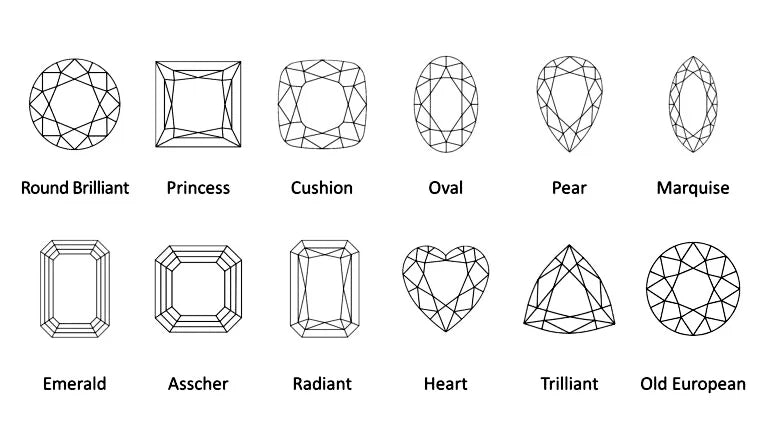
Bring Your Dream Jewelry to Life
At Sarah Lee Jewelry, our expert designers turn your vision into a breathtaking reality. From concept to creation, we work closely with you to craft a one-of-a-kind masterpiece that reflects your unique style and story. Collaborate with us and experience the joy of wearing a truly bespoke piece.
